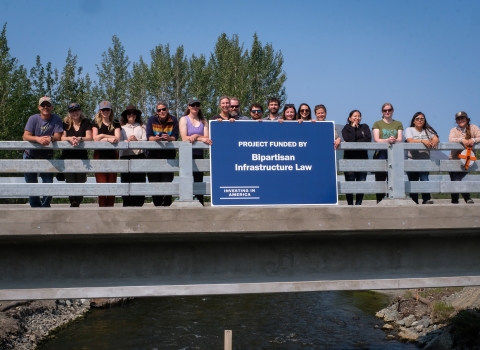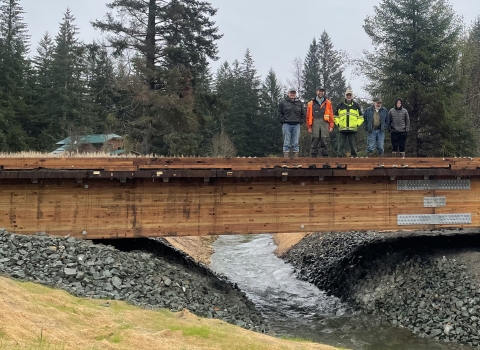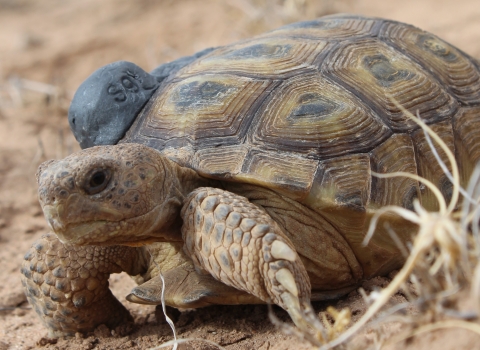Alaska—The Department of the Interior has announced a $4 million investment in fiscal year 2023 funding from President Biden’s Bipartisan Infrastructure Law Bipartisan Infrastructure Law
The Bipartisan Infrastructure Law (BIL) is a once-in-a-generation investment in the nation’s infrastructure and economic competitiveness. We were directly appropriated $455 million over five years in BIL funds for programs related to the President’s America the Beautiful initiative.
Learn more about Bipartisan Infrastructure Law for six projects in Alaska that will improve fish and flood passage where roads cross rivers used by both migrating fish and local communities. Alaska projects funded this round are located in the Copper River basin, Tyonek, Port Graham, Metlakatla, Yakutat, and near Ninilchik at Deep Creek.
The announcement is part of the Department’s five-year $200 million commitment to restore free-flowing waters, allowing fish migration and protecting communities from flooding rivers and streams; three Alaska projects also received $3.5 million of this funding in 2022 for projects in Gustavus (completed), a tributary to the Copper River (underway), and Tyonek (begins this year).
It is also part of an over $3 billion investment in fish passage fish passage
Fish passage is the ability of fish or other aquatic species to move freely throughout their life to find food, reproduce, and complete their natural migration cycles. Millions of barriers to fish passage across the country are fragmenting habitat and leading to species declines. The U.S. Fish and Wildlife Service's National Fish Passage Program is working to reconnect watersheds to benefit both wildlife and people.
Learn more about fish passage and aquatic connectivity projects under the Investing in America agenda, which includes funding from the Bipartisan Infrastructure Law and Inflation Reduction Act.
“President Biden’s Bipartisan Infrastructure Law provides a once-in-a-generation opportunity to invest in our nation’s rivers, streams and communities and help restore habitat connectivity for aquatic species around the country,” said Secretary Deb Haaland. “As the effects of climate change climate change
Climate change includes both global warming driven by human-induced emissions of greenhouse gases and the resulting large-scale shifts in weather patterns. Though there have been previous periods of climatic change, since the mid-20th century humans have had an unprecedented impact on Earth's climate system and caused change on a global scale.
Learn more about climate change continue to intensify, Tribal Nations in particular are facing unique climate-related challenges that threaten resources vital to Indigenous communities. These fish passage investments will support community-led transitions and facilitate long-term conservation and economic growth in these areas.”
All of the submitted project proposals were collaboratively developed through local partnerships. Proposals were ranked locally before going through a national selection process led by an interdisciplinary panel of experts from multiple federal agencies.
This year, there are 23 projects that have Tribal involvement and nine projects that are Tribally-led. All of Alaska’s funded projects partner with Alaska Native Entities, through direct awards to Native Corporations and Tribal Conservation Districts, sub-awards to Native non-profits, or by working closely with local Tribes for project selection and implementation. Despite there being more projects than could ultimately be funded, the quality of submissions was excellent and demonstrated the strength of local partnerships and co-stewardship efforts. U.S. Fish and Wildlife Service staff in Alaska are committed to continuing to work with Tribes, communities and partners to build capacity for fish passage improvements and flood-resilient infrastructure.
“Across the country there are millions of barriers that block viable corridors for fish and other aquatic wildlife to access spawning grounds, food sources and safe water. This historic law is giving these aquatic species a chance,” said U.S. Fish and Wildlife Service Director Martha Williams. “Funding from the Bipartisan Infrastructure Law bolsters our efforts to improve fish passage that ultimately conserves freshwater and migratory fish and wildlife, promotes safer community infrastructure, and encourages climate resiliency.”
This investment delivers on one of the America the Beautiful initiative’s six early focus areas (supporting collaborative conservation of fish and wildlife habitat and corridors) and is consistent with the Administration’s Corridors and Connectivity Guidance.
The rivers, streams and coastal systems of North America once supported vast annual runs of fish such as Atlantic salmon, American shad, Pacific salmon and steelhead. These species and many others, including some at-risk and listed species, depend on connected streams and high-quality habitat to survive. During the past 200 years, many of these populations have decreased drastically, in large part due to the proliferation of barriers like dams and undersized culverts, and watershed development that blocks fish from their natural migrations.
Alaska is not immune to these issues. In fact, there are currently over 3,800 documented barriers to fish movement and migration remaining and more are being found. Each barrier removed benefits Alaska’s anadromous and resident fishes that are woven into the fabric of communities and cultures across Alaska and beyond. And while all six funded Alaskan projects will directly benefit anadromous salmon integral to the culture and economy of Alaska and Alaska Native Peoples, there is more work to do. Thankfully there are more funding opportunities coming available in the near future.
#
Upcoming BIL Funding Opportunities
Background
The Service’s National Fish Passage Program is a leader in pulling partners together to restore connectivity to fragmented rivers. The program provides financial, engineering and planning assistance to communities, Tribes, states and landowners to support barrier removal and river restoration projects. Since 1999, the program has worked with over 2,000 partners to remove or bypass over 3,400 barriers to fish passage and reopen access to over 61,000 miles of upstream habitat for fish and other animals.
Our Southern Alaska Fish and Wildlife Field Office has dedicated staff working with partners to conserve fish and wildlife via habitat restoration and conservation, fish assessment and management, technical assistance, cost-sharing, funding, and outreach.
A multi-agency interactive map featuring Bipartisan Infrastructure Law funded fish passage projects can be viewed on the newly-launched Fish Passage Portal. More details are available on the U.S. Fish and Wildlife Service’s website.





